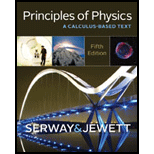
Concept explainers
(a)
The location of the particle and the charges on them.
(a)
Answer to Problem 18P
The location on first particle is
The location on second particle is
Explanation of Solution
Write the expression of standard equation for the potential difference.
Here,
Write the expression of standard equation for the electric filed.
Here,
Write the expression for the given potential difference.
Here,
Write the expression for the given electric field.
Here,
Conclusion:
Comparing equation (II) and (IV), the first particle is having charge with magnitude
The location of the first particle is
Thus, The location on first particle is
Comparing equation (II) and (IV), the second particle is having charge with magnitude
The location of the second particle is
Thus, the location on second particle is
(b)
The force acting on charge -16.0 nC.
(b)
Answer to Problem 18P
The force acting on charge -16.0 nC is
Explanation of Solution
Rewrite the expression for the given electric field from equation (IV).
Write the expression for the force action on the charge.
Here,
Conclusion:
Substitute
Thus, the force acting on charge -16.0 nC is
(c)
The work done required to move the charge.
(c)
Answer to Problem 18P
The work done required to move the charge is
Explanation of Solution
Rewrite the expression for the given potential difference by using equation (III).
Write the expression for the required work done.
Here,
Conclusion:
Substitute
Thus, the work done required to move the charge is
Want to see more full solutions like this?
Chapter 20 Solutions
Principles of Physics
- A point charge of 4.00 nC is located at (0, 1.00) m. What is the x component of the electric field due to the point charge at (4.00, 2.00) m? (a) 1.15 N/C (b) 0.864 N/C (c) 1.44 N/C (d) 1.15 N/C (e) 0.864 N/Carrow_forwardA very small ball has a mass of 5.00 103 kg and a charge of 4.00 C. What magnitude electric field directed upward will balance the weight of the ball so that the ball is suspended motionless above the ground? (a) 8.21 102 N/C (b) 1.22 104 N/C (c) 2.00 102 N/C (d) 5.11 106 N/C (e) 3.72 103 N/Carrow_forwardA 1.75-nC charged particle located at the origin is separated by a distance of 0.0825 m from a 2.88-nC charged particle located farther along the positive x axis. If the 1.75-nC particle is kept fixed at the origin, where along the positive x axis should the 2.88-nC particle be located so that the magnitude of the electrostatic force it experiences is twice as great as it was in Problem 27?arrow_forward
- A very small ball has a mass of 5.00 103 kg and a charge of 4.00 C. What magnitude electric field directed upward will balance the weight of the ball so that the ball is suspended motionless above the ground? (a) 8.21 102N/C (b) 1.22 104N/C (c) 2.00 102N/C (d) 5.11 106 N/C (e) 3.72 103 N/Carrow_forwardA circular ring of charge of radius b has a total charge q uniformly distributed around it. Find the magnitude of the electric field in the center of the ring. (a) 0 (b) keq/b2 (c) keq2/b2 (d) keq2/b (e) None of these answers is correct.arrow_forwardAn electron with a speed of 3.00 106 m/s moves into a uniform electric field of magnitude 1.00 103 N/C. The field lines are parallel to the electrons velocity and pointing in the same direction as the velocity. How far does the electron travel before it is brought to rest? (a) 2.56 cm (b) 5.12 cm (c) 11.2 cm (d) 3.34 m (e) 4.24 marrow_forward
- A uniformly charged ring of radius R = 25.0 cm carrying a total charge of 15.0 C is placed at the origin and oriented in the yz plane (Fig. P24.54). A 2.00-g particle with charge q = 1.25 C, initially at the origin, is nudged a small distance x along the x axis and released from rest. The particle is confined to move only in the x direction. a. Show that the particle executes simple harmonic motion about the origin. b. What is the frequency of oscillation for the particle? Figure P24.54arrow_forwardIs it possible for a conducting sphere of radius 0.10 m to hold a charge of 4.0 C in air? The minimum field required to break down air and turn it into a conductor is 3.0 106 N/C.arrow_forward
 Principles of Physics: A Calculus-Based TextPhysicsISBN:9781133104261Author:Raymond A. Serway, John W. JewettPublisher:Cengage Learning
Principles of Physics: A Calculus-Based TextPhysicsISBN:9781133104261Author:Raymond A. Serway, John W. JewettPublisher:Cengage Learning Physics for Scientists and Engineers, Technology ...PhysicsISBN:9781305116399Author:Raymond A. Serway, John W. JewettPublisher:Cengage Learning
Physics for Scientists and Engineers, Technology ...PhysicsISBN:9781305116399Author:Raymond A. Serway, John W. JewettPublisher:Cengage Learning Physics for Scientists and Engineers: Foundations...PhysicsISBN:9781133939146Author:Katz, Debora M.Publisher:Cengage Learning
Physics for Scientists and Engineers: Foundations...PhysicsISBN:9781133939146Author:Katz, Debora M.Publisher:Cengage Learning College PhysicsPhysicsISBN:9781305952300Author:Raymond A. Serway, Chris VuillePublisher:Cengage Learning
College PhysicsPhysicsISBN:9781305952300Author:Raymond A. Serway, Chris VuillePublisher:Cengage Learning College PhysicsPhysicsISBN:9781285737027Author:Raymond A. Serway, Chris VuillePublisher:Cengage Learning
College PhysicsPhysicsISBN:9781285737027Author:Raymond A. Serway, Chris VuillePublisher:Cengage Learning




